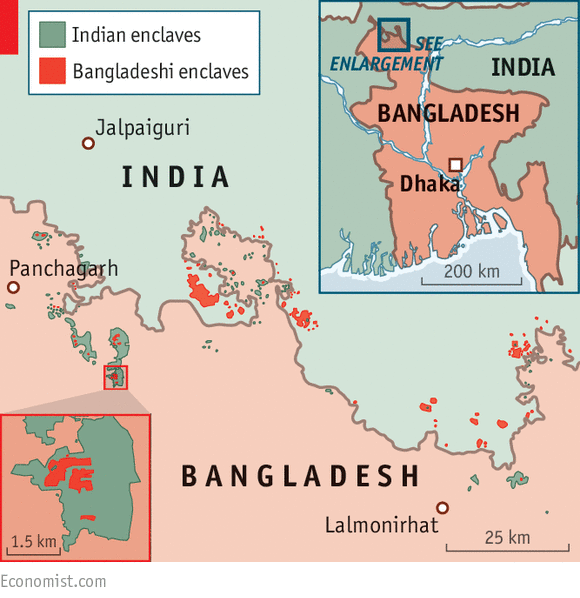A cartographic anomaly is resolved
SOUTH Asian cartography has many quirks, but few are stranger than a stretch of India’s border with northern Bangladesh. Here, ever since partition in 1947, when Bangladesh was part of Pakistan, there have been 162 parcels of land on either side of the border that belong to the other side (see map). With an agreement reached between India’s prime minister, Narendra Modi, and his Bangladeshi counterpart, Sheikh Hasina, on June 6th, that anomaly is about to end.
The enclaves were there long before partition. Legend has it that they were formed as a result of a series of chess games played between two maharajahs centuries ago. The chunks of land were used as wagers. Brendan Whyte of the National Library of Australia believes the parcels were carved out as a result of 18th-century treaties between the Maharajah of Cooch Behar and the Mughal empire, before the emergence of the British Raj. The territories include the world’s only “counter-counter-enclave”: a patch of India surrounded by Bangladeshi territory, inside an Indian enclave within Bangladesh.
Ms Hasina turned up at the airport with several cabinet members to meet Mr Modi, eager to receive a stamp of approval from the leader of the world’s biggest democracy. During his visit, Mr Modi also signed 20 or so other agreements, covering bus routes across the border, investments in the energy sector and more.
Once celebrated for helping an independent Bangladesh break away from Pakistan in 1971, India has since come to be regarded by many Bangladeshis as an overbearing, and sometimes even wicked, stepmother. Mr Modi’s visit was to show that relations have moved to a new phase involving more trade and goodwill rather than squabbles over territory, cross-border terrorism and illegal migration.
And, after decades of dithering, they were able to clear up the bizarre legacy of their shared border. Until now the 50,000 people in the enclaves were effectively stateless, living on patches of land without schools, hospitals or courts. Now they are to be given the option to choose which side to join, along with citizenship and basic services. The pact will cover a total area of 40 square kilometres (15 square miles)—about half the size of Hong Kong island.
Mr Modi said, in all seriousness, that the agreement on the enclaves was comparable in importance to the dismantling of the Berlin Wall. Yet India’s actions elsewhere along the border have not matched such rhetoric. It is busy raising a fortified fence along much of the border to help stanch the flow of migrants and smugglers. Between January and May Indian forces killed 20 Bangladeshis trying to cross the border illegally. A resolution on the enclaves is one thing; free movement between the two countries quite another.
Source: The Economist









